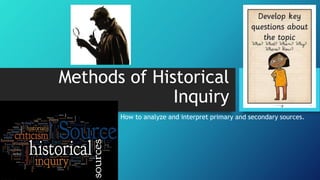
Methods of Historical Inquiry
- 1. Methods of Historical Inquiry How to analyze and interpret primary and secondary sources.
- 2. Last class… • We looked at the hurdles historians face in relation to primary and secondary sources. • What were some of the hurdles we looked at?
- 3. Can you identify which of these hurdles relate to primary sources, secondary sources, or both primary and secondary sources? • Bias • Propaganda • Inaccurate information • Insufficient of information • Lost knowledge of language • Forgeries • Misinterpretation of primary sources • False citations • Primary and Secondary • Primary and Secondary • Primary and Secondary • Primary • Primary • Primary • Secondary • Secondary
- 4. So how do we, as budding historians, avoid these traps? • That’s what we’ll be looking at now…
- 5. What is historical research? Historical research means gathering and analyzing information to better understand the past. Again, it is a lot like solving a mystery. Anyone who wants to do this research well, must be careful to understand any shortcomings in their sources.
- 6. Step One: Know the mystery you want to solve and formulate your question. • There are a number of reasons you may want to investigate some mystery of the past…
- 7. You may find a new source and want to investigate it— investigate what information it adds to our under- standing of the past. “Oh, wow! Look what I found! I wonder what time period this is from and what this tells us about the culture.”
- 8. You may want to know about a certain event or element of culture. “Hmmm…I wonder what Neanderthal culture was like. I think I’ll go research”
- 9. You may question the accuracy in the way a secondary source interprets primary sources or explains some element of history. “Hmmm…this seems biased. I think I’ll check out another source to see an alternative explanation.”
- 10. Don’t forget to express your historical quest in a clear question. For example: • “What does the fish on this old Hindu artifact which I found buried in my backyard symbolize?” • “What was the diet of the Incas” • “Is Barack Obama really a Muslim born in Africa?” (these are two allegations put forth by some Republicans and discussed on Fox News.)
- 11. Step Two: Gather as many sources as possible. • After you’ve formulated your question, you need to gather your sources. • It is best to have as many sources as possible and to have a wide variety of sources, such as paintings from the time, other artifacts, original written documents, secondary sources, etc.
- 12. Step Three: Analyzing Your Sources
- 13. When analyzing a source, it is important to remember and employ the 6 C’s 1. CONTENT (What?): 1. Look carefully at what is being communicated by the source 2. CITATION (Who?): 1.Who created the text? 3. CONTEXT (When?): 1.When was the source created and what time is the source talking about? What was going on at the time it was created and the time period with which the soure deals? 4. CONNECTIONS (How?: 1.How is the source be linked to other sources and information you already know about? 5. CRITICAL THINKING (Why?): 1.Why was this source made? Is it objective? Emotional? Biased? Is it factual or a cultural reflection, such as art? Is it accurate? 6. CONCLUSION (What is the value?): 1.What is the historical value of this source? How does it contribute to our understanding of history?
- 14. Step Four: Synthesizing • Synthesize means mix together into a meaningful, coherent whole. It means putting all the clues together to come to a conclusion
- 15. Step Five: Communicating What You’ve Learned Finally, you need to be able to communicate your information and your conclusions to other people. You need to cite your sources and you need to explain how you arrived at your conclusions. There are many ways to communicate…how many can you come up with?
- 16. Communicating! • Video • Speaking • Writing • Art • Graph or chart • Theatrical performance • Writing and performing a song • Powerpoint • Multimedia, using multiple forms of communication such as those mentioned above.
- 17. To Sum Up… 1. Formulate a question 2. Gather resources 3. Evaluate resources 1. Content—What? 2. Citation—Who? 3. Context—When? 4. Connections—How? (How does this fit in with what I know from other sources?) 5. Critical Thinking—Why? (was this created) 6. Conclusion—What is the historical value of this source? 4. Synthesize all you’ve learned from your sources 5. Communicate what you’ve learned.
